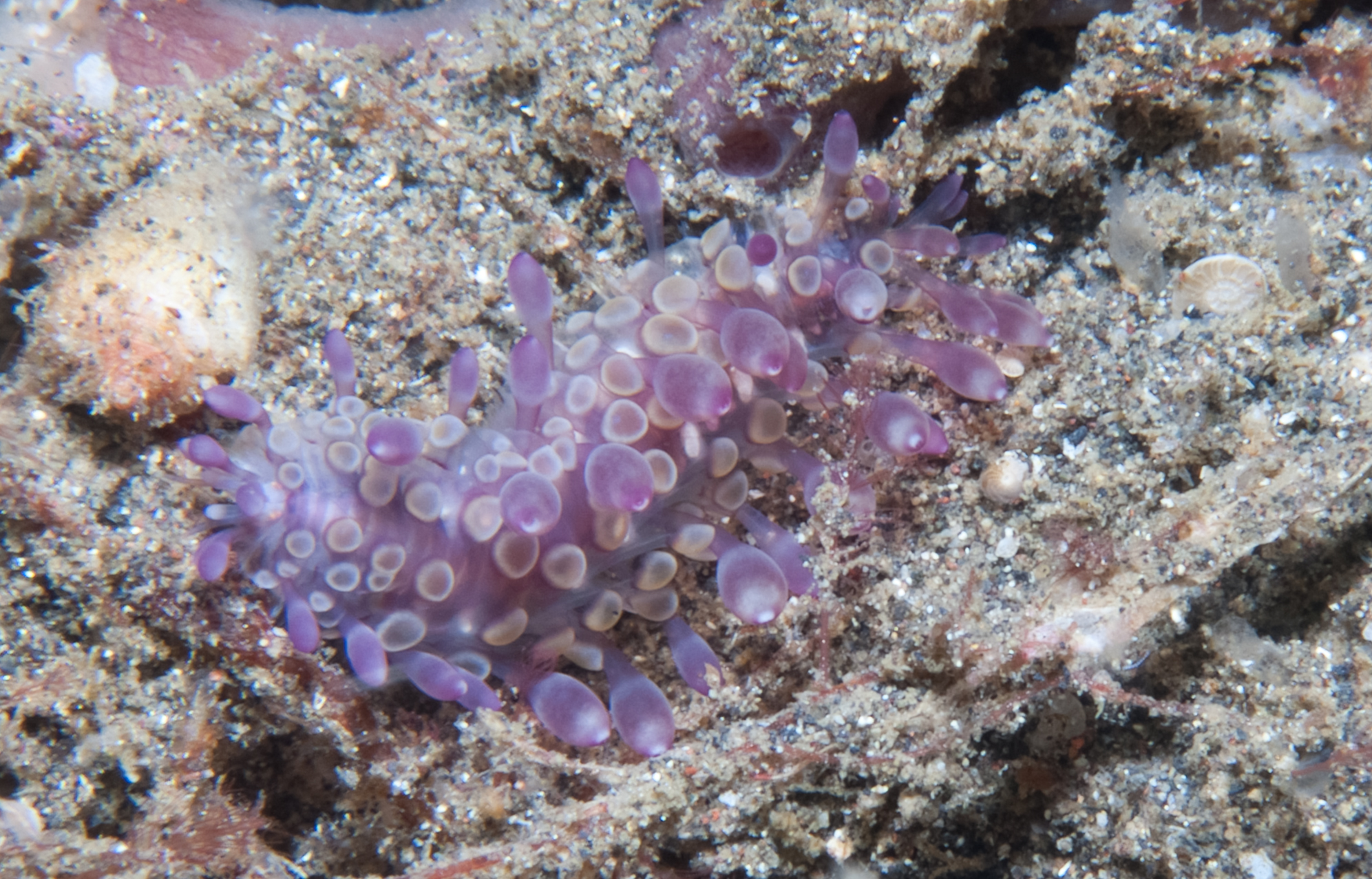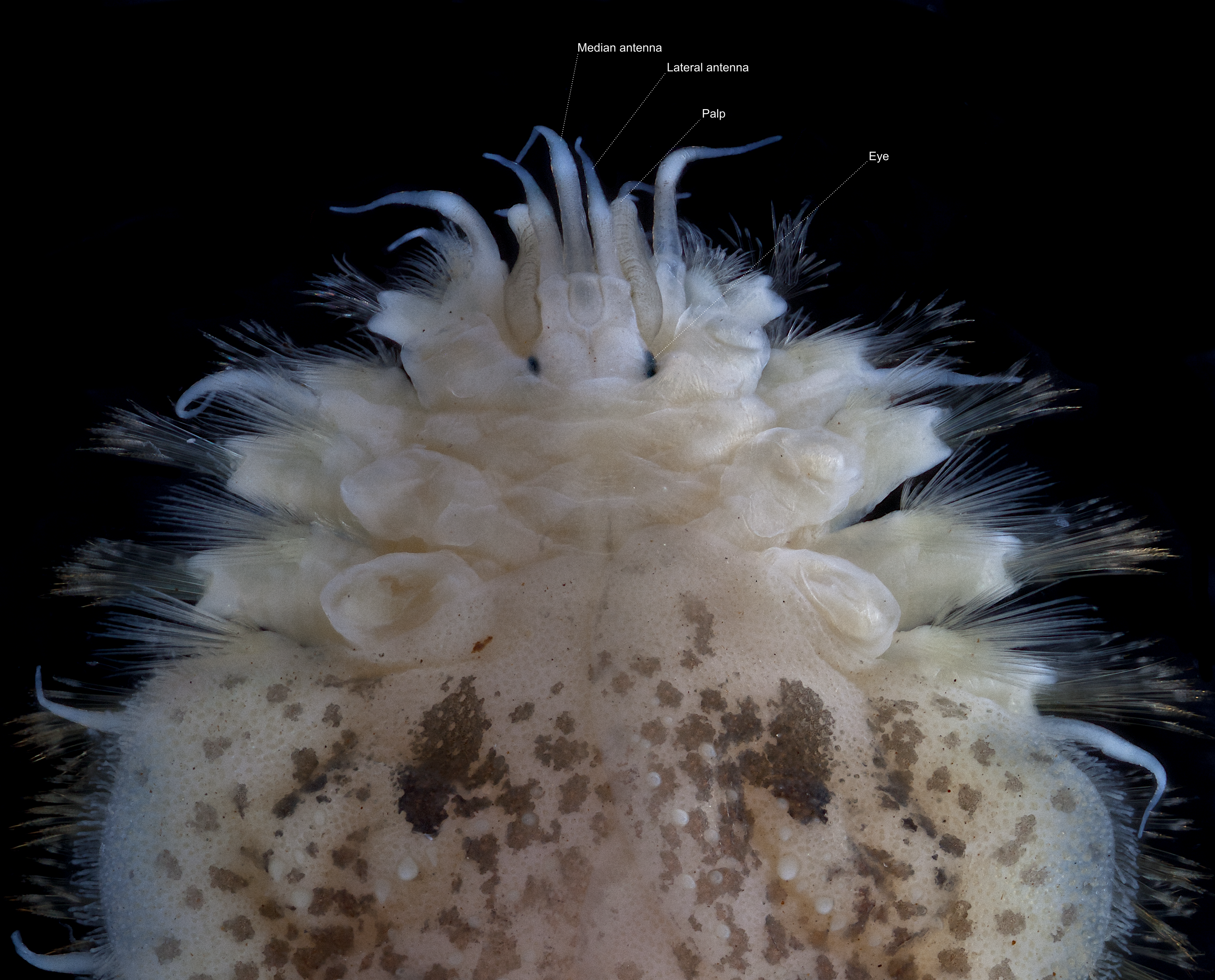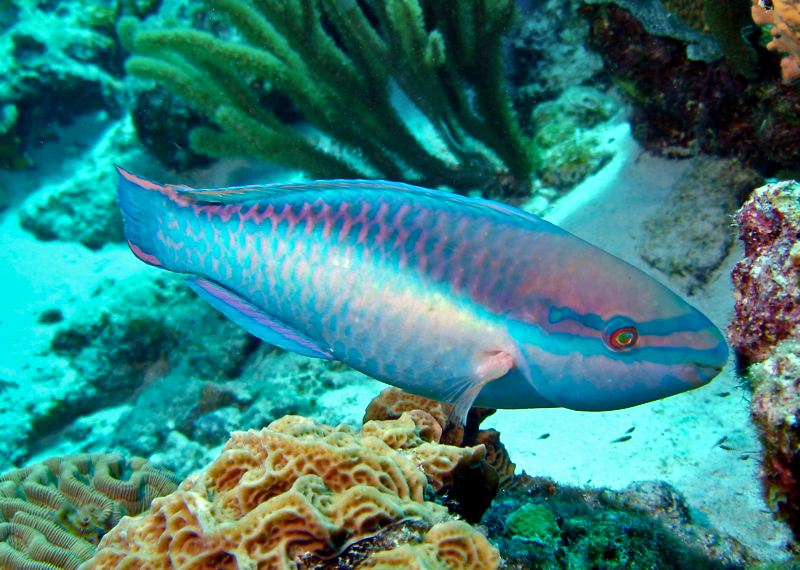|
Tottonpolynoe
''Tottonpolynoe'' is a genus of marine polychaete worms belonging to the family Polynoidae, the scaleworms. ''Tottonpolynoe'' contains a single species, ''Tottonpolynoe symantipatharia''. It is known from the South Pacific Ocean and Southern Ocean at depths of about .Pettibone, M.H. (1991). Polynoid polychaetes commensal with antipatharian corals. Proceedings of the Biological Society of Washington. 104(4): 714-726., available online at https://www.biodiversitylibrary.org/page/34809416 Description ''Tottonpolynoe symantipatharia'' is a long-bodied scale worm comprising between 55 and 71 segments with 16 pairs of elytra. The elytra are large, delicate and cover the dorsum on the anterior part of the body but not on posterior segments. The prostomium is bilobed with widely spaced triangular cephalic peaks. The lateral antennae are inserted ventrally, directly beneath the median antenna ceratophore. The neuropodium is elongate and tapering. The notochaetae are smooth and about as ... [...More Info...] [...Related Items...] OR: [Wikipedia] [Google] [Baidu] |
Polynoidae
Polynoidae is a family of marine Polychaete worms known as "scale worms" due to the scale-like elytra on the dorsal surface. Almost 900 species are currently recognised belonging to 9 subfamilies and 167 genera. They are active hunters, but generally dwell in protected environments such as under stones. The group is widely distributed from shallow intertidal waters to hadal trenches. They are the most diverse group of polychaetes in terms of genus number and second most diverse in terms of species number which is almost 8% of all segmented worm species. Description Most Polynoidae species are short and flattened, but can reach as much as 20 cm in length and 10 cm width in ''Eulagisca gigantea'' and ''Eulagisca uschakovi''. Individuals are usually covered almost entirely by elytra, which can be shed and regenerated in many species. The elytra of some species are faintly bioluminescent, and leave glowing traces around the mouthparts of their predators, making those preda ... [...More Info...] [...Related Items...] OR: [Wikipedia] [Google] [Baidu] |
Polychaeta
Polychaeta () is a paraphyletic class of generally marine annelid worms, commonly called bristle worms or polychaetes (). Each body segment has a pair of fleshy protrusions called parapodia that bear many bristles, called chaetae, which are made of chitin. More than 10,000 species are described in this class. Common representatives include the lugworm (''Arenicola marina'') and the sandworm or clam worm ''Alitta''. Polychaetes as a class are robust and widespread, with species that live in the coldest ocean temperatures of the abyssal plain, to forms which tolerate the extremely high temperatures near hydrothermal vents. Polychaetes occur throughout the Earth's oceans at all depths, from forms that live as plankton near the surface, to a 2- to 3-cm specimen (still unclassified) observed by the robot ocean probe ''Nereus'' at the bottom of the Challenger Deep, the deepest known spot in the Earth's oceans. Only 168 species (less than 2% of all polychaetes) are known from f ... [...More Info...] [...Related Items...] OR: [Wikipedia] [Google] [Baidu] |
Pacific Ocean
The Pacific Ocean is the largest and deepest of Earth's five oceanic divisions. It extends from the Arctic Ocean in the north to the Southern Ocean (or, depending on definition, to Antarctica) in the south, and is bounded by the continents of Asia and Oceania in the west and the Americas in the east. At in area (as defined with a southern Antarctic border), this largest division of the World Ocean—and, in turn, the hydrosphere—covers about 46% of Earth's water surface and about 32% of its total surface area, larger than Earth's entire land area combined .Pacific Ocean . '' Britannica Concise.'' 2008: Encyclopædia Britannica, Inc. The centers of both the |
Southern Ocean
The Southern Ocean, also known as the Antarctic Ocean, comprises the southernmost waters of the World Ocean, generally taken to be south of 60° S latitude and encircling Antarctica. With a size of , it is regarded as the second-smallest of the five principal oceanic divisions: smaller than the Pacific, Atlantic, and Indian oceans but larger than the Arctic Ocean. Over the past 30 years, the Southern Ocean has been subject to rapid climate change, which has led to changes in the marine ecosystem. By way of his voyages in the 1770s, James Cook proved that waters encompassed the southern latitudes of the globe. Since then, geographers have disagreed on the Southern Ocean's northern boundary or even existence, considering the waters as various parts of the Pacific, Atlantic, and Indian oceans, instead. However, according to Commodore John Leech of the International Hydrographic Organization (IHO), recent oceanographic research has discovered the importance of Southern ... [...More Info...] [...Related Items...] OR: [Wikipedia] [Google] [Baidu] |
Elytron (Annelida)
In annelids, elytra (; from Greek Greek may refer to: Greece Anything of, from, or related to Greece, a country in Southern Europe: *Greeks, an ethnic group. *Greek language, a branch of the Indo-European language family. **Proto-Greek language, the assumed last common ancestor ... ἔλυτρον "sheath, cover"; singular: elytron ) are shield-like scales that are attached dorsally, one pair on each of a number of alternating segments and entirely or partly cover the dorsum. Elytra are modified dorsal cirri, and their number, size, location, and ornamentation are important taxonomic characters. The basal part of the elytra is known as the elytrophore; if (as is often the case) elytra are lost their presence is indicated by the elytrophore which is still present and visible. Annelids possessing elytra are also known as "scale worms". Possession of elytra is characteristic of the annelid suborder Aphroditiformia. Gallery File:Eunoe leiotentaculata lower res.jpg, A '' Eunoe ... [...More Info...] [...Related Items...] OR: [Wikipedia] [Google] [Baidu] |
Prostomium
The prostomium (From Ancient Greek, meaning "before the mouth"; plural: prostomia; sometimes also called the "acron") is the cephalized first body segment in an annelid worm's body at the anterior end. It is in front of (but does not include) the mouth, being usually a small shelf- or lip-like extension over the dorsal side of the mouth. The prostomium together with the peristomium, which includes the mouth and pharynx, make up the annelid head. Description The prostomium is part of the head and holds at least part of the brain and often bears sensory structures such as the eyes, antennae and palps. It may function like a kind of overlip when the animal is feeding. The prostomium bears many important taxonomic characters and its shape and composition are important for annelid systematics. In addition to the eyes, antennae and palps, the prostomium can possess appendages such as tentacles or cirri. Moreover, some polychaete prostomia have a posterior extension or ridge with ... [...More Info...] [...Related Items...] OR: [Wikipedia] [Google] [Baidu] |
Parapodium
In invertebrates, the term parapodium ( Gr. ''para'', beyond or beside + ''podia'', feet; plural: parapodia) refers to lateral outgrowths or protrusions from the body. Parapodia are predominantly found in annelids, where they are paired, unjointed lateral outgrowths that bear the chaetae. In several groups of sea snails and sea slugs, 'parapodium' refers to lateral fleshy protrusions. __TOC__ Annelid parapodia Most species of polychaete annelids have paired, fleshy parapodia which are segmentally arranged along the body axis. Parapodia vary greatly in size and form, reflecting a variety of functions, such as gas exchange, anchorage, protection and locomotion. General description Parapodia in polychaetes can be uniramous (consisting of one lobe or ramus) but are usually biramous (two lobes or rami). In the latter case, the dorsal lobes are called notopodia and the ventral lobes neuropodia. Both neuropodia and notopodia may possess a bundle of chaetae (neurochaetae and notochaet ... [...More Info...] [...Related Items...] OR: [Wikipedia] [Google] [Baidu] |
Chaeta
A chaeta or cheta (from Greek χαίτη “crest, mane, flowing hair"; plural: chaetae) is a chitinous bristle or seta found in annelid worms, (although the term is also frequently used to describe similar structures in other invertebrates such as arthropods). Polychaete annelids, ('polychaeta' literally meaning "many bristles") are named for their chaetae. In Polychaeta, chaetae are found as bundles on the parapodia, paired appendages on the side of the body. The chaetae are epidermal extracellular structures, and clearly visible in most polychaetes. They are probably the best studied structures in these animals. Use in taxonomy and identification The ultrastructure of chaetae is fundamentally similar for all taxa but there is vast diversity in chaetal morphology. Moreover, chaetae bear precise characters for determination of species and taxonomic assessment. The shape, absolute and relative size, number, position, ornamentation and type are important taxonomic characters a ... [...More Info...] [...Related Items...] OR: [Wikipedia] [Google] [Baidu] |
Commensal
Commensalism is a long-term biological interaction (symbiosis) in which members of one species gain benefits while those of the other species neither benefit nor are harmed. This is in contrast with mutualism, in which both organisms benefit from each other; amensalism, where one is harmed while the other is unaffected; parasitism, where one is harmed and the other benefits, and parasitoidism, which is similar to parasitism but the parasitoid has a free-living state and instead of just harming its host, it eventually ends up killing it. The commensal (the species that benefits from the association) may obtain nutrients, shelter, support, or locomotion from the host species, which is substantially unaffected. The commensal relation is often between a larger host and a smaller commensal; the host organism is unmodified, whereas the commensal species may show great structural adaptation consistent with its habits, as in the remoras that ride attached to sharks and other fishes. Remo ... [...More Info...] [...Related Items...] OR: [Wikipedia] [Google] [Baidu] |
Black Coral
Antipatharians, also known as black corals or thorn corals, are an order of soft deep-water corals. These corals can be recognized by their jet-black or dark brown chitin skeletons, surrounded by the polyps (part of coral that is alive). Antipatharians are a cosmopolitan order, existing at nearly every location and depth, with the sole exception of brackish waters. However, they are most frequently found on continental slopes under deep. A black coral reproduces both sexually and asexually throughout its lifetime. Many black corals provide housing, shelter, food, and protection for other animals. Black corals were originally classified in the subclass Ceriantipatharia along with ceriantharians (tube-dwelling anemones), but were later reclassified under Hexacorallia. Though they have historically been used by Pacific Islanders for medical treatment and in rituals, its only modern use is making jewelry. Black corals have been declining in numbers and are expected to continue d ... [...More Info...] [...Related Items...] OR: [Wikipedia] [Google] [Baidu] |
Alcyonacea
Alcyonacea, or soft corals, are an order of corals. In addition to the fleshy soft corals, the order Alcyonacea now contains all species previously known as "gorgonian corals", that produce a more or less hard skeleton, though quite different from "true" corals (Scleractinia). These can be found in suborders Holaxonia, Scleraxonia, and Stolonifera. They are sessile colonial cnidarians that are found throughout the oceans of the world, especially in the deep sea, polar waters, tropics and subtropics. Common names for subsets of this order are sea fans and sea whips; others are similar to the sea pens of related order Pennatulacea. Individual tiny polyps form colonies that are normally erect, flattened, branching, and reminiscent of a fan. Others may be whiplike, bushy, or even encrusting. A colony can be several feet high and across, but only a few inches thick. They may be brightly coloured, often purple, red, or yellow. Photosynthetic gorgonians can be successfully kept in c ... [...More Info...] [...Related Items...] OR: [Wikipedia] [Google] [Baidu] |

.jpg)






